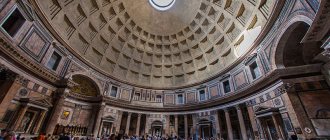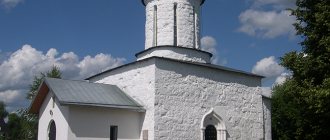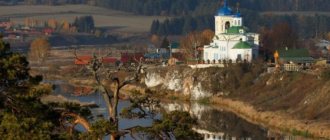The importance of the church in people's lives
Each nation has its own special faith, but in general all people are divided into two categories: those who believe in God and those who do not recognize his existence. The first group always had the opportunity to visit a religious building - a church. There, in the sacred temple, a person found peace and repented of grave sins; he sought forgiveness and indulgence, comfort and warmth within the walls of the building and found it. Each building, as a rule, had a dome; it gives the church a particularly solemn appearance. It was made from the best materials, which shone brightly in the sun and attracted the attention of all travelers. This wonderful creation of the architects gave the sacred temple a magical meaning and a touch of magic. Thus, anyone traveling, tired on the road or lost could visit the church and find help, warmth and God there.
Notes
| Buddhist | Prang • Pagoda • Sala • Stupa • Kumbum • Tahoto • Tak-phu • Chaitya |
| Pagan | Mithraeum • Monopterus • Nymphaeum • Naisk • Temple • Gontina • Serapeum • Megalithic Temples of Malta • Mandir |
| Plan and volumes | Naos • Pronaos • Opisthodome • Nave • Apse • Quadrangle • Octagon • Chapel • Choir • Gallery • Middle Cross |
| Premises | Exonarthex • Narthex • Crown of Chapels • Chapel • Crypt • Basement • Carillon • Vima • Pulpit • Altar • Transept • Confessional • Empora |
| Bearing structures | Pillar • Column • Arcade • Frame system of Gothic architecture • Buttress • Flying buttress • Rib |
| Vaults and ceilings | Arch • Vault • Conch • Sail • Tromp • Drum • Head • Dome • Tent • Crane • Zakomara • Kokoshnik • Plowshare • Sky |
| Temple buildings | Belfry • Carillon • Bell tower • Campanile • Chapel • Chapel • Baptistery • Ciborium • Cemetery • Cloister • Refectory • Martyrium |
What does a dome mean in the religions of different peoples?
The religion of every nation has its own distinctive features, but almost all of them have a church dome. Its meaning is also different. For example, the design is considered extremely important for Christian and Muslim architecture. Many Catholic, Orthodox and other churches, mosques and cathedrals have stunning domes. Some beliefs attach symbolic meaning to the design. For the Orthodox, this is a sign of heaven, which is associated with God, the Heavenly Kingdom and Angels.
[edit] Types of domes
[edit] Byzantine dome
Byzantine or sail domes are a sail whose bases do not simply form arches to support the dome above it, but converge in the center of the space and thus form a dome themselves. Finishes of this kind are similar to a square sail, fixed at the bottom at the four corners.
These domes are among the simplest structures: to maintain their shape, unlike helmet domes, it is not necessary to create a wooden or metal frame or fill the internal space with bricks.
According to the most common opinion, the Byzantine type of temple completion dominated in Rus' (Kyiv, Chernigov, Smolensk, etc.) until the Mongol invasion.
Thus, it was the Byzantine (sail) domes that were used in the construction of the Kyiv and Polotsk St. Sophia Cathedrals.
[edit] Onion dome
Onion domes have a convex shape with a smooth point at the top and look like an onion. Traditionally used in Russia, Turkey, India and the Middle East. These domes usually have a larger diameter than the base on which they stand, and their height exceeds their width.
According to the most common opinion, set out in a number of textbooks, reference books, scientific and popular works, onion domes first began to be used in the architecture of the Moscow state in the 2nd half. XVI century
Some researchers consider this architectural element as borrowed from Muslims; there are other explanations.
The meaning of the word Dome according to the Brockhaus and Efron dictionary:
Dome - in architecture, a covering of a round, quadrangular or polyhedral space, representing from the inside the concave surface of a hemisphere, a spherical segment, a segment of an ellipsoid, or generally any body of rotation and resembling an overturned bowl (Italian cupola, from the word cupo = concavity, recess). A roof can be wooden, made of clay, or metal, but this term primarily means a vaulted covering made of brick or stone. The origin of K. is lost in ancient times. Thus, it is found in the prehistoric monuments of Gaul, in the nuragenes of Sardinia, in the funerary monuments of Lydia, in the treasuries of primitive Greece (for example, the treasury of Atreus, in Mycenae), in Etruscan funeral crypts, in the Nubian pyramid of Kurna, etc., but more In all, it was apparently in use among the ancient Chaldeans and Persians, as evidenced by the images of their buildings that have reached us and archaeological excavations carried out in the locations of their long-vanished cities. The architecture of classical Greece almost did not resort to the K form... nevertheless, it is presented to us by the monolith covering the small choragy monument of Lysicrates in Athens. Stone K., of a regular vaulted design, appeared for the first time among the Romans, who, having developed techniques for its masonry, during the flourishing period of their art boldly used it to cover even very vast spaces, such as, for example, in the Pantheon of Agrippa (see), in which the hemispherical The building, equipped with a round hole at the top to allow light to pass through, covers a round building 43 1/2 m in diameter. Later, K. became a favorite form of covering in Byzantine architecture, for the first time successfully solving the problem of placing it above the base of not only a round, but also a square and generally polygonal plan, namely through the construction of pandants, or sails (see Byzantine art). Improved in this way, K. spread from Byzantium throughout all its provinces and countries that were subject to its influence, moved to the West - to Italy (the Ravenna baptismal church and the church of St. Vitaly, the Venetian Cathedral of St. Mark), to the banks of the Rhine (the imperial chapel, in Aachen), to France (Church of the Holy Front, in Perigueux), was inherited by Muslim art, Armenia, Georgia and Russia. The highest degree of development of sculpture was achieved in the Italian architecture of the Renaissance (C. Brunelleschi, in the Florence Cathedral, Michelangelo’s painting above the Roman Cathedral of St. Peter, etc.). In modern architecture, the ceiling is placed, for the most part, not directly on the walls of the space it covers, but between them and it, a more or less high cylindrical vestibule (drum) is erected between them and it, as an intermediary link, cut through by windows that serve to illuminate both the chamber itself, and the under-dome part of the building. However, the vestibule was also used in Byzantine temple construction. Sometimes, for better illumination of the hole, a round hole is made at its top, over which the so-called so-called hole is erected. The lantern is the second small K., supported by a vestibule with windows. From K., in the buildings of modern times, are especially remarkable for their size, skillful design and grace: in France - K. church. Invalides and the Pantheon, in Paris. in England - London's St. Paul, in Germany - Schinkel K. Berlin Royal Museum. in Russia - Moscow. Cathedral of Christ the Savior and St. Isaac's Cathedral in St. Petersburg. Among the ancient Romans, the casing was decorated from the inside with cutting in the form of protruding vertical and horizontal ribs, forming cassettes, and in Byzantine architecture - with mosaic images on a golden background. in modern architecture it is given to painting, mainly fresco. A
.
S
-
v.
Structurally
,
modern spherical structures are the simplest of all.
vaults, and cutting it, to obtain the appearance of the individual stones or wedges that make it up, is carried out using meridional planes and mating conical surfaces, with the apex in the center. Between the two mating surfaces a ring is formed, bounded by these surfaces and the inner and outer surface K. Each complete ring, consisting of wedge-shaped stones, being completely closed and resting on the lower ring, is in equilibrium. This property of the ceiling makes it possible to arrange holes of arbitrary sizes at its top (navel), which do not in any way reduce the stability of the arch, and this provides an extremely convenient way to illuminate the ceiling from above. For the same reason, when laying walls from small material (brick), you can do without circles, since individual rows of wedges are very slightly inclined to the horizon and, forming a closed ring, do not need support. The thickness of the arch is determined by the pressure that falls on the heels of the roof from the weight of the dome load. Depending on this, the thickness dimensions in other sections of the arch are determined. When checking the strength of light and medium-sized joints, the adhesion of the mortar in the seams is also taken into account. When designing a cathedral, serious attention is particularly required to ensure the stability of the supporting walls, which converge at the corners of the temple and support the drum with the help of intermediate cylindrical arches. The damage found in a significant number of churches indicates in most cases the need either to install buttresses at the corners of high, unstable walls, or to reduce the effect of thrust on them from the wall using iron ties (Church of St. Peter in Rome, the Church of St. Vladimir in Chersonese, etc.). If K. tends to move the abutment or drum apart, then, to prevent further destruction, they can be tightened with iron rings. Recently, improvements in through-metal roofing systems have led to the construction of iron roofs, primarily for covering round factories, etc., buildings serving industrial purposes. The dome system here is made up of individual elastic connections located along meridional and parallel circles, which are connected by diagonal connections for greater stability (Schwedler system). The frames of the buildings of the Berlin gas tank consist of 4-5 polygonal rings and 24 radial rafter legs. the lantern ring forms a 12-gon. These buildings, with a span of 32 to 44 m, are covered with cardboard. There are similar cones with a hole larger than 50 m. A parabola is usually taken as the generatrix of a metal end-to-end cone for the middle part. K. on a cubic parabola theoretically requires 2/3 of the material that goes on the same K. on an ordinary parabola. A
.
T.
Dome (military) - see Tower.
Development of dome construction
During the Renaissance, the period of the most acute development of dome construction began. In the fifteenth and sixteenth centuries, such hemispheres were built in the cathedrals of Santa Maria del Fiore and St. Peter. These were truly divine designs made by true professionals. During Baroque times, the church dome was considered the largest element of the building.
Starting from the nineteenth century, domes began to be built not only in sacred temples, but also in government institutions. Constructions of this type were also present in ordinary houses, but this happened extremely rarely. During this period, golden domes of churches became extremely popular. In addition to the noble metal, other materials were also used, such as glass and reinforced concrete. In the twentieth century, the use of hemispheres became several times more popular. From this period, domes were erected in sports institutions, entertainment venues, and so on.









